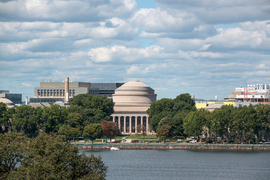Earlier today, MIT Admissions released demographic data about the undergraduate Class of 2028, the first class of students admitted after the Supreme Court’s decision in Students for Fair Admissions (SFFA) v. Harvard that banned the consideration of race in undergraduate admissions. As Dean of Admissions and Student Financial Services Stu Schmill ’86 anticipated in a blog post last June, the court’s decision has resulted in a decline in the proportion of enrolling first-year students who are members of historically under-represented racial and ethnic groups.
MIT News spoke with Schmill about this change, why diversity matters for the MIT education, and what happens next; Schmill also wrote a personal reflection on the MIT Admissions blog.
Q: What is the impact of the Supreme Court’s decision on MIT’s Class of 2028?
A: Last June, the Supreme Court ruled that colleges and universities that receive federal funding may no longer consider race in undergraduate admissions decisions. As I explained in a blog post at the time, we expected that this would result in fewer students from historically underrepresented racial and ethnic groups enrolling at MIT. That’s what has happened.
As a baseline, in recent years around 25% of our enrolling undergraduate students have identified as Black, Hispanic, and/or Native American and Pacific Islander. For the incoming Class of 2028, that number is about 16%. (For comparison, federal data show that 45% of K-12 students in American public schools are classified as members of these groups.)
While this is a substantial change in the demographic composition of the Class of 2028 compared with recent years, I want to be clear that it does not bring any aggregate change in the quantifiable characteristics we use to predict academic success at MIT, such as performance in high school or scores on standardized tests. By these measures, this cohort is no more or less prepared to excel in our curriculum than other recent classes that were more broadly diverse.
I emphasize this essential fact because many people have told me over the years that MIT ought to care only about academic excellence, not diversity. But every student we admit, from any background, is already located at the far-right end of the distribution of academic excellence. In my time as dean, we have considered only applicants who meet our extremely high threshold of academic readiness. Recognizing the substantial educational benefits of diversity, we then worked to assemble from that highly qualified group a class that reflected both breadth and excellence in its collective interests, aptitudes, and experiences.
The evidence of our success in achieving both academic excellence and broad diversity is in our outcomes, both on and beyond our campus. In recent years, as MIT has grown more diverse, collective academic performance has improved, as have retention and graduation rates, which are now at all-time highs for students from all backgrounds. At the same time, according to data from the American Society for Engineering Education, over the last 10 years MIT has graduated more engineers from historically underrepresented racial and ethnic groups than any other private college or university (and almost all public universities) in the United States, while at the same time being widely regarded as the world’s leading STEM institution and an important engine of innovation. These simultaneous achievements by our community represent a synthesis of — not a tension between — diversity and excellence.
Q: Why does diversity matter in an MIT education?
A: I am convinced, from empirical data and personal experience, that the MIT education is strongest when our student body is, above a high bar of academic excellence, broadly diverse.
Any MIT alum can tell you that they learned as much from their peers as their professors; certainly that was as true for me as a Course 2 [mechanical engineering major] in the 1980s as it is for my advisees today. When you bring together people with different ideas and experiences who share common interests, aptitudes, and match for MIT’s mission, they contribute their individual talents to collective excellence.
We also need this diversity in order to attract the very best students. As MIT has become more diverse, more of the most talented students in the country from all backgrounds have chosen to enroll at MIT — and they specifically tell us in surveys that attending a diverse institution is important to them and that they value this quality in their MIT experience.
It should not really be surprising that today’s students prefer a diverse campus community: They come from the most multiracial, multiethnic, multicultural generation of Americans that has ever existed. So another reason we care about diversity is that it makes us the strongest magnet of talent for the next generation of scientists, engineers, and knowledge-creators.
Q: Why did MIT need to consider race in the past to achieve diverse classes?
A: As we argued in an amicus brief in the SFFA case, the educational benefits of diversity are well established. Empirical evidence demonstrates that what matters for creativity and innovation is having highly qualified people with a wide variety of experiences and backgrounds working together as a team to generate new solutions to hard problems.
Unfortunately, there remains persistent and profound racial inequality in American K-12 education, and it is most pronounced in STEM. This means that carrying the diversity of American public schools forward into higher ed is difficult from the word go.
Let’s start with these troubling facts: According to federal data, among public high schools where 75% or more of students are Black and/or Hispanic:
- nearly two-thirds do not offer calculus;
- more than half do not offer any form of computer science; and
- nearly half do not offer any form of physics.
Research shows that students who do not have the opportunity to build a strong foundation in math and science in high school are much less likely to succeed in graduating with a degree in STEM. Meanwhile, research from Stanford University’s Educational Opportunity Project shows that school segregation — which is strongly associated with achievement gaps — has steadily increased since the early 1990s. By some measures, school segregation now approaches levels not seen since Brown v. Board of Education 70 years ago.
In the everyday work of the MIT Admissions office, we see firsthand the startling extent of ongoing educational inequality in the U.S.: Whether we are out on the road or at home reading applications, we can see differences in opportunity from state to state, district to district, school to school, and even sometimes within schools.
We have tried to help close these gaps by directing prospective students toward free resources to help them better prepare for college-level STEM work, whether at MIT or anywhere else. In my blog post today, I talk about MIT’s long history of broadening access to educational opportunity to students from all backgrounds. I believe MIT can, will, and must do even more to open the aperture of opportunity in the future.
Q: What does all this mean?
A: Well, before the SFFA decision we were able to use race as one factor among many to identify well-prepared students who emerged from the unequal K-12 educational environment. We could see that these students met our high academic standards of excellence, were well-matched to our education, and would thrive at MIT.
Following the SFFA decision, we are unable to use race in the same way, and that change is reflected in the outcome for the Class of 2028. Indeed, we did not solicit race or ethnicity information from applicants this year, so we don’t have data on the applicant pool. But I have no doubt that we left out many well-qualified, well-matched applicants from historically under-represented backgrounds who in the past we would have admitted — and who would have excelled.
I want to emphasize that this change in the composition of our incoming class is not due to our reinstated testing requirement. In fact, the class we admitted last year under the testing requirement had the highest proportion of students from historically underrepresented racial and ethnic backgrounds in MIT history, because universal testing helped us identify objectively well-qualified students who lacked other avenues to demonstrate their preparation. As I explained at the time, standardized tests are certainly imperfect, but they are, in important respects, less unequal than other things we can consider.
We will continue to use the tests to help identify students who could not otherwise demonstrate their preparation for our education; however, the SFFA decision limits our ability to select, from among the well-qualified pool of applicants, a class that purposefully draws from a broad range of backgrounds.
Q: Where does MIT go from here?
A: Given the clear educational benefits, we still consider many kinds of diversity: prospective fields of study and areas of research, extracurricular activities and accomplishments, as well as economic, geographic, and educational background — just not race.
After the decision, we responded with expanded recruitment and financial aid initiatives designed to improve access to MIT for students from all backgrounds. These efforts include a new targeted outreach program to identify and encourage students in rural America to apply to MIT. They also include a new policy under which most families earning less than $75,000 a year pay nothing to attend — the kind of clear commitment that has been shown to lower barriers. It also allowed us to quintuple the number of students we match through QuestBridge, a national talent search program for high-achieving, low-income students of all backgrounds, and represents a continued commitment from MIT leadership to keeping our education affordable for everyone through the $165 million that we devote annually to undergraduate financial aid.
Clearly, we still need to do more to ensure MIT remains a destination for the best talent from all backgrounds. My team has been meeting with faculty, student, and administrative leadership to gather ideas on what we might do going forward. And in her community message today, President Kornbluth underscored her commitment to making an MIT education accessible to those “whose talent and potential have been masked or limited” by structural and social factors, as was the charge of the Task Force on Educational Opportunity chaired by former MIT president Paul Gray back in 1968. Through this ongoing work, we seek to find the best path forward for the Institute of today and for future generations.
To be clear, there is no quick and easy “hack” to solve for racial inequality. But MIT does not shrink from hard problems in science or in society, and we will do what we can, within the bounds of the law, to continue to deliver an exceptionally rigorous and inclusive educational experience that our current, former, and future students can be proud of.









